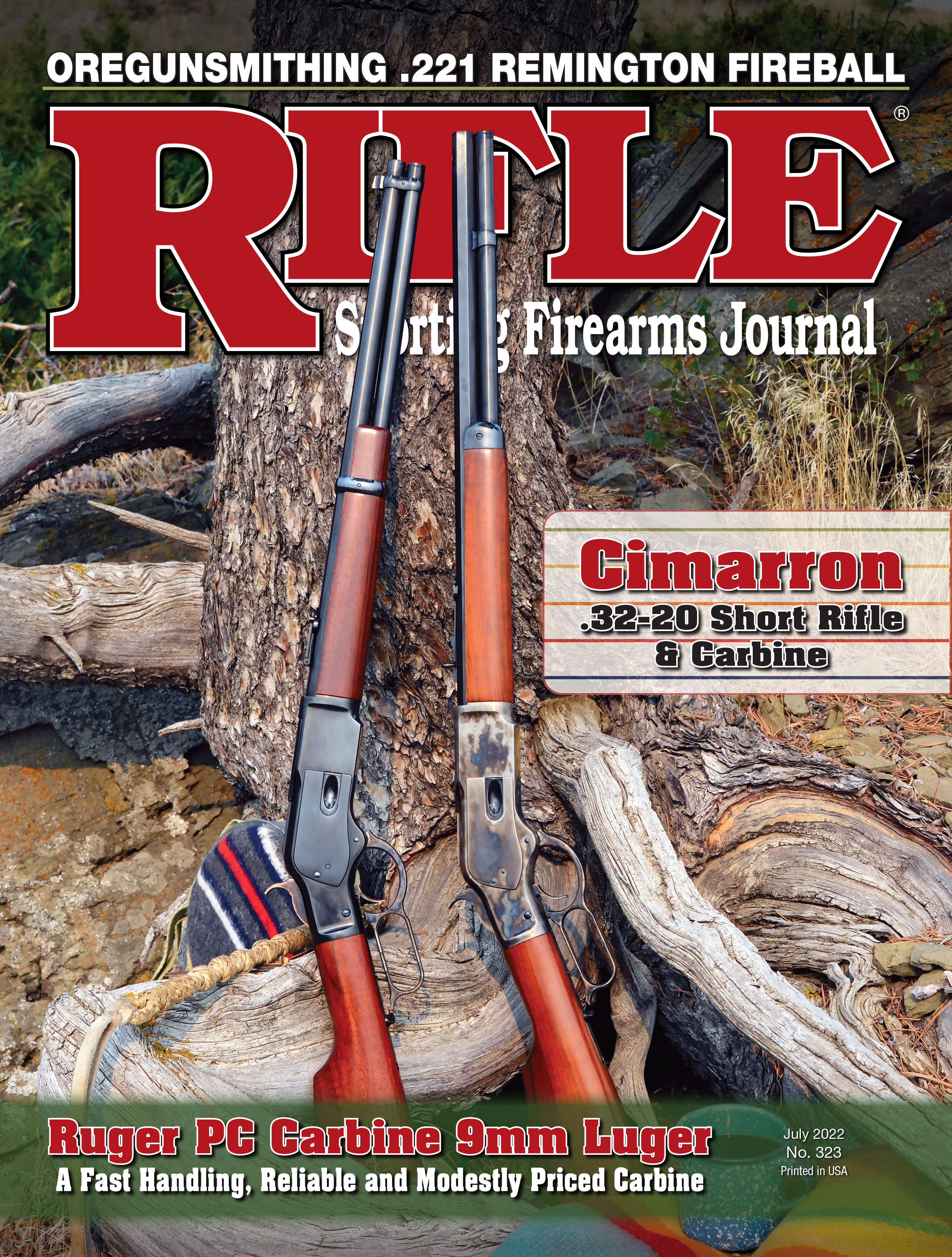Rifle July/August 2022
On the Cover: A Cimarron/Uberti Model 1873 .32-20 saddle ring carbine and a Short Rifle.
Volume 54, Number 4 | ISSN:
Article Bites
Lock, Stock & Barrel
Rifles Worth Keeping
column by: Lee J. Hoots
It’s not unusual for gun scribes to become tired or disenchanted with a rifle or pistol for one reason or another. ...Read More >
Mostly Long Guns
Handloading to Improve the .223 Remington
column by: Brian Pearce
“The dial regulation is off on both of my scopes. They are supposed to be set up specifically for .223 Remington and 5.56 NATO loads with a 55-grain bullet at 3,240 feet per second (fps). However, I always have to either dial more to get on target, or holdover to make hits.” ...Read More >
Down Range
Moving Iron Sights
column by: Mike Venturino
A rifle not zeroed is completely useless in so far as hitting anything specific. My rifle shooting career started with modern optical sights. Getting them mounted and zeroed is a relatively easy chore, which I’ve accomplished with many dozens rifles and scopes. However, sometimes one’s interests take a different path. For decades my primary rifle shooting has been with metallic iron sights. Ironically, zeroing iron-sighted rifles can be more complicated than scopes, because the sights themselves must be physically moved. ...Read More >
Light Gunsmithing
Annoying Traits
column by: Gil Sengel
The first thought to come to mind when considering gunsmithing that can be done in the home shop is simple parts replacement. Firing pins, extractors and metal injection molded parts chip or break; bolt stops and old-style (not plunger-type) ejectors become so battered with use that they malfunction on occasion. Generally easy stuff. ...Read More >
A Rifleman’s Optics
Bushnell Elite 4500 4x 4-16x 50mm Multi-X Scope
column by: Patrick Meitin
I own a couple Bushnell Elite 6500 4.5-30x 50mm scopes, one each with BDC and Mil-Dot reticles. They have been on two of my most serious varmint rifles for close to 10 years, get used hard in wet, cold and dusty conditions, and have yet to let me down in any way. Bushnell has always been a brand I could count on, so this comes as no surprise. These were $1,000 optics at the time of purchase. ...Read More >
Walnut Hill
Through a Glass, Brightly
column by: Terry Wieland
Along about 1988, Jim Carmichel, then shooting editor of Outdoor Life, wrote an article about optical equipment imported from Europe. At the top of the tree, in both reputation and price, were riflescopes, binoculars and spotting scopes from Zeiss, in what was then West Germany. ...Read More >
Oregunsmithing .221 Remington Fireball
Shooting a Custom Rifle
feature by: Patrick Meitin
As an obsessive varmint shooter, the vast majority of my rifles fall somewhere between the .17 HMR/.17 Hornet for the smallest ground squirrels shot at reasonable ranges or close to civilization, to the 6mm Creedmoor/Remington to reach way out there on larger targets such as rockchucks or coyotes. In between are the varmint rounds used most, the .204 Ruger and .223 Remington large among them – or at least until recently. Lately, I’ve come to prefer the somewhat forsaken .221 Remington Fireball. ...Read More >
Ruger PC Carbine 9mm Luger
A Fast Handling, Reliable and Modestly Priced Carbine
feature by: Brian Pearce
Ruger has introduced a top-notch, semiautomatic-loading carbine chambered in 9mm Luger and .40 Smith & Wesson (S&W), which for good reason has become very popular. The PC Carbine boasts of many trending features that make it appealing, but most importantly, it offers reliability and carries an attractive price tag. ...Read More >
Cimarron
.32-20 Short Rifle & Carbine
feature by: Mike Venturino - Photos by Yvonne Venturino
In the heyday of Winchester Repeating Arms Company lever guns, it offered muskets, standard rifles, short rifles and saddle ring carbines. My 50-year-old dictionary defines carbine simply as a short rifle. Winchester didn’t consider them so. It’s definition of a Model 1873 short rifle was that its configuration was exactly the same as a standard ’73 rifle, except its barrel length and magazine tube was 20 inches instead of 24 inches. Therefore, short rifles had crescent steel buttplates, steel forearm caps, buckhorn rear sights with blade fronts. Rear sight elevation was provided by a notched slider and both rear and front sights were dovetailed to either round or octagonal barrels. Therefore, they could be drifted laterally for windage zeroing. ...Read More >
The Pattern 1853 Rifle-Musket
A Brief History
feature by: Terry Wieland
There are many ways one could approach a story about the Enfield Pattern 1853 rifle-musket. First, of course, is its short but spectacular military career; second would be a purely scientific point of view, and how it advanced the fields of gunmaking and ballistics; third is its profound influence on infantry tactics – on how battles are fought and soldiers are trained. ...Read More >
The Perfect Gopher Rifle
An Inexpensive Solution to Subdivision Varmints
feature by: John Barsness
Many hunters and non-hunters think of Montana as pretty much wilderness, teeming with elk and grizzly bears, but some of the state has filled in considerably over the last few decades, nowhere more so than in and around Bozeman, where I was born and raised. Back then, its population was 12,000; today its “metropolitan statistical area” that holds almost 10 times as many people, with more moving in every day. ...Read More >


